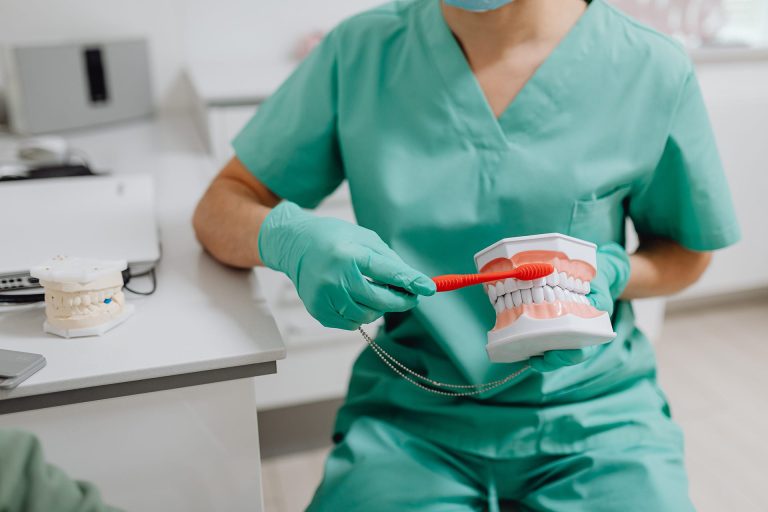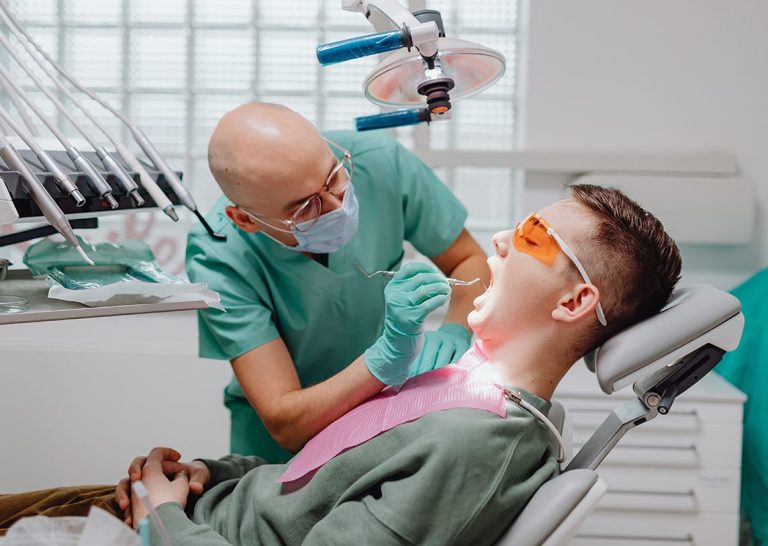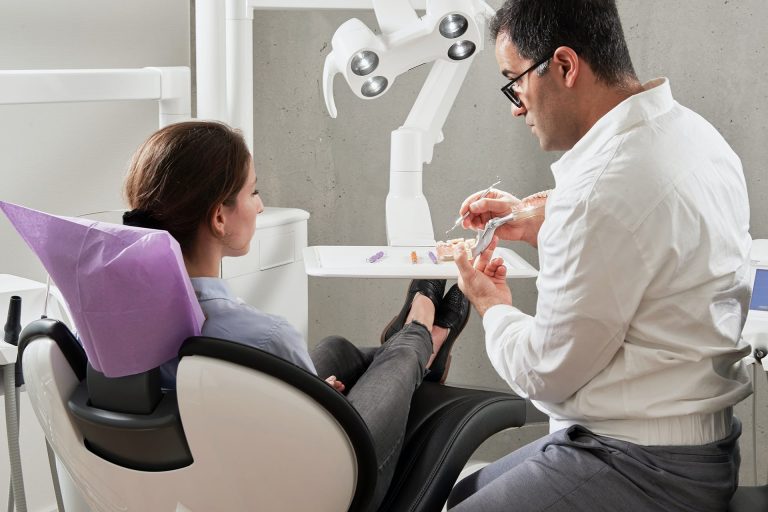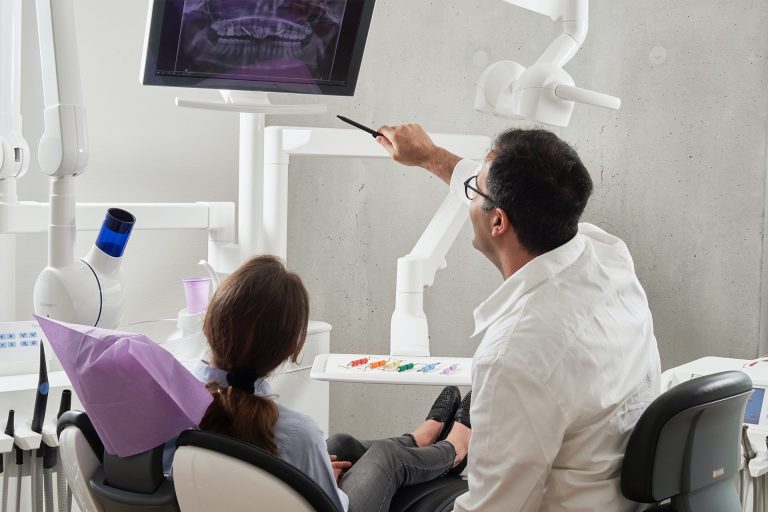Ever had that moment where you’re standing in front of the mirror, dental floss in hand, staring at your braces and wondering, How on earth am I supposed to floss with these things? Well, you’re not alone. Many people with braces share this common predicament, but fret not, because flossing with braces doesn’t have to be a daunting task. With the right tools and techniques, it can be just as simple as flossing without braces.
To floss with braces, you’ll need a floss threader or orthodontic floss. Thread the floss under the wire and then between your teeth, gently moving up and down. Repeat this for every tooth, ensuring optimal dental hygiene while wearing braces.
Understanding the Importance of Flossing with Braces
Maintaining oral hygiene is a multifaceted task, and when you have braces, it becomes even more critical. One vital component of this routine is flossing.
The Role of Flossing in Dental Hygiene
Flossing is not merely an additional step in your dental care regimen. It plays a pivotal role in maintaining oral health by removing food particles and plaque between your teeth and along the gum line where your toothbrush cannot reach. It aids in preventing gum disease, tooth decay, and bad breath—issues that can be exacerbated when braces are part of the equation.
When you have braces, bits of food and plaque have even more places to hide, making flossing all the more vital.
Why Flossing with Braces is Crucial
Flossing with braces may seem like a daunting task, but it’s a non-negotiable part of maintaining good oral health. The brackets and wires create additional nooks and crannies where food particles can get lodged, increasing the risk of plaque buildup and cavities.
Moreover, braces create an environment that can lead to decalcification or the loss of minerals from your teeth. Flossing helps to mitigate this risk by removing food particles and plaque that could contribute to this issue. Regular and effective flossing can help keep your teeth and gums healthy while you’re wearing braces, ensuring a beautiful smile when they come off.
The Consequences of Not Flossing with Braces
Neglecting to floss with braces can have significant repercussions. When food particles and plaque are left untouched, they can cause a series of oral health problems.
Firstly, this can lead to gingivitis, a condition characterized by inflamed, bleeding gums. If left untreated, it can progress to periodontitis, a severe gum disease that can result in tooth loss.
Additionally, the buildup of plaque can lead to demineralization, resulting in white spots on your teeth. These spots can often be permanent, marring the appearance of your newly straightened smile.
Lastly, failure to floss can result in bad breath, which can affect your confidence and social interactions.
Overall, understanding the importance of flossing with braces helps maintain your oral health and ensures that your investment in orthodontic treatment results in a healthy, beautiful smile. Regular flossing, while often overlooked, is a crucial element in the larger picture of oral hygiene. Ensuring you incorporate this into your daily routine can help you avoid the potentially severe consequences of neglecting this crucial task.
Types of Floss for Braces
Managing oral hygiene, particularly flossing, can be a daunting task when you have braces. However, several types of floss have been specifically designed to make this task easier and more effective. Let’s delve into these different types of floss to help you maintain optimal oral health while wearing braces.
Traditional Dental Floss
Firstly, traditional dental floss is a tried-and-true method of cleaning in between your teeth. This thin, string-like material is usually waxed to allow for smoother gliding between the teeth and braces. It’s a versatile option, suitable for tight spaces, and it comes in various thicknesses and flavors. However, using traditional dental floss can be time-consuming and might require more dexterity as you have to thread it under the main wire of your braces.
Orthodontic Flossers
Next up, orthodontic flossers are specifically designed for individuals with braces. These handy tools have a stiff end that easily threads under braces, and a spongy floss section to clean around your braces and between your teeth. They’re easier to handle than traditional floss and can save you time, but it’s worth noting that they can be more expensive.
Floss Threaders
Floss threaders are another excellent tool for those with braces. These plastic, needle-like tools are used to thread the floss under the braces wire, allowing you to effectively clean between your teeth and along the gum line. While they can be used with any type of floss, they do require patience and practice to use effectively.
Water Flossers
Finally, water flossers, or oral irrigators, are devices that use a high-pressure water jet to clean between your teeth and around your braces. They are incredibly effective at removing food particles and plaque without the need for threading. Water flossers can reach areas that traditional floss can’t, providing a thorough clean. While they are the most expensive option, they are also the most comfortable and easiest to use.
Overall, the best type of floss for you heavily depends on your personal preference, budget, and comfort. It is crucial to maintain a regular flossing routine with braces to prevent plaque buildup, cavities, and gum disease. Always discuss your flossing options with your orthodontist or dental professional to ensure you are using the most effective tools for your unique situation.
Step-by-Step Guide on How to Floss with Braces
Maintaining oral hygiene with braces can be quite a challenge. But with the right techniques and tools, you can keep your teeth and gums healthy. Let’s dive into the specifics.
Preparing Your Flossing Equipment
Start by making sure you have all your flossing equipment handy. This includes traditional dental floss, orthodontic flossers, floss threaders, and water flossers. Each type of floss has its unique advantages and is suited to different aspects of brace care.
The Process of Flossing with Traditional Dental Floss
Flossing with braces using traditional dental floss involves some finesse. Break off about 18 inches of floss and wind the majority around your middle fingers, leaving a small amount to work with. Carefully thread the floss between the brace wire and your teeth. Gently move the floss up and down, following the curve of your teeth. Repeat this process for each tooth, taking special care not to apply too much pressure on the brace wire.
How to Use Orthodontic Flossers
Orthodontic flossers are designed to navigate the complexities of braces. These are available in most drugstores. To use, insert the stiff end of the flosser under the archwire of your braces. Next, press the floss against your teeth and slide it up and down between your teeth and braces. Once you’re done, remove it and move on to the next section.
Using Floss Threaders for Braces
Floss threaders offer a handy solution for threading floss under the brace wire. Simply thread your floss through the loop of the threader, then guide the threader under the wire. Now, you can floss as you normally would.
The Right Way to Use Water Flossers
Water flossers, also known as oral irrigators, are another effective tool for brace care. They work by directing a stream of pulsating water to flush out food and plaque. To use, fill the reservoir with warm water, position the tip at a 90-degree angle to your teeth, and switch on the device. Glide the tip along your gumline and brace wire, pausing briefly between teeth.
Overall, each of these methods plays a vital role in maintaining oral hygiene with braces. Practicing these techniques regularly can help keep your teeth and gums healthy, and your braces free from food particles and plaque. Remember, the goal is not just straight teeth, but healthy teeth and gums as well.
Common Challenges in Flossing with Braces and How to Overcome Them
Maintaining oral hygiene when wearing braces can be a challenging task. You often encounter various obstacles that hinder your ability to floss effectively. However, understanding these challenges and the ways to overcome them can make your flossing experience a lot more manageable.
Difficulty in Reaching Tight Spaces
The first challenge you may encounter when flossing with braces is reaching those tight spaces. Traditional flossing methods may not be as effective due to the presence of brackets and wires. However, there are innovative solutions available to help you tackle this issue.
Floss threaders, for instance, are designed to help you guide the floss underneath the wire of your braces. This tool allows you to access those hard-to-reach areas and remove any trapped food particles, thus maintaining your oral hygiene. Moreover, the use of water flossers can also be an effective solution. This appliance uses a pressurized stream of water to remove plaque and food debris from between your teeth and along the gum line.
Time-Consuming Flossing Process
Flossing with braces can indeed be a time-consuming process. It requires patience and precision to ensure that your teeth and braces are thoroughly clean. However, this shouldn’t deter you from maintaining good oral hygiene practices.
To expedite the flossing process, you might want to try using an orthodontic flosser. This tool is specifically designed for people with braces and can significantly reduce the time spent on flossing. Furthermore, adopting a systematic approach can also help. Start from one end of the mouth and work your way to the other end, ensuring that no tooth is missed in the process.
Dealing with Pain or Discomfort While Flossing
Flossing with braces might cause some discomfort or pain, particularly if your braces have been recently adjusted. While it’s normal to experience some sensitivity, there are measures you can take to alleviate this discomfort.
One effective strategy is to use waxed floss as it is gentler on your gums and less likely to get caught on your braces. Moreover, using a water flosser can also be a less painful alternative, as it cleans your teeth and gums without the need for rigorous flossing.
Managing Broken Wires or Brackets During Flossing
Broken wires or brackets can indeed be a major concern when flossing. They can cause discomfort and even potentially damage your mouth. If you encounter a broken wire or bracket while flossing, don’t panic.
The first and most important step is to contact your orthodontist immediately. In the meantime, you can use orthodontic wax to cover the broken wire or bracket and prevent it from poking your gums or cheeks. Remember, never try to fix the broken wire or bracket yourself, as this could lead to further complications.
Overall, although flossing with braces can present a few challenges, with the right techniques and tools, you can effectively maintain your oral hygiene. The key is to be patient, persistent, and consult your orthodontist regularly. Remember, a beautiful and healthy smile is well worth the effort.
Tips and Tricks for Effective Flossing with Braces
Maintaining oral hygiene is essential, especially when you’re undergoing orthodontic treatment. Flossing with braces can be quite challenging, however, with a few simple tips and tricks, you can make it a breeze.
The Ideal Frequency of Flossing
Dental professionals recommend flossing at least once a day. This frequency helps to remove food particles and prevent plaque build-up in the hard-to-reach areas around your braces. Flossing once a day may seem daunting, but it’s crucial for warding off cavities and gum disease. Remember, consistency is the key to effective flossing.
Best Time to Floss for People with Braces
The optimal time to floss if you have braces is before bed. This ensures that you remove all the food particles and plaque accumulated during the day before you sleep. Flossing at night also allows you to take your time without the rush of morning routines. However, if you find it difficult to stick to this schedule, try to floss at a time that works best for you. The goal is to make flossing a regular part of your dental hygiene routine.
Proper Maintenance of Flossing Tools
Maintaining your flossing tools is as important as flossing itself. Ensure to rinse your floss threader after each use and replace it regularly. If you’re using a reusable floss pick or interdental brush, clean it thoroughly under running water after each use and replace it when the bristles start to fray or the pick becomes dull. It’s also advisable to keep your flossing tools in a clean, dry place to prevent bacterial growth.
Additional Dental Hygiene Practices for Those with Braces
Apart from regular flossing, incorporating additional dental hygiene practices can ensure optimal oral health for those with braces. Brushing your teeth at least twice a day, using a fluoride toothpaste, is highly recommended. Using an antimicrobial mouthwash can help reduce the bacteria in your mouth and mitigate the risk of gum disease. Lastly, regular dental checkups are crucial to monitor your oral health and the progress of your orthodontic treatment.
Overall, flossing with braces requires a little extra time and patience, but with the right tools, frequency, and techniques, it’s entirely manageable. Alongside flossing, maintaining a comprehensive dental hygiene routine will ensure your oral health remains in top condition throughout your orthodontic journey.
Flossing with Braces: What to Expect in the First Few Weeks
When you first start flossing with braces, it’s normal to experience a mix of anticipation and apprehension. You’re embarking on a journey towards a more confident smile, but it’s a path laden with unfamiliar challenges. Here’s what you can expect in those initial weeks.
Initial Discomfort and Its Management
In the initial phase, you may experience a certain level of discomfort. The sensation of the floss navigating around the archwires and brackets of your braces can be odd, and at times, mildly painful. This is normal – your gums are adjusting to their new companions.
To manage this discomfort, opt for waxed floss. Its smooth texture can reduce the friction and make the process more comfortable. You can also use a topical oral gel to numb the area before flossing. This can help reduce the sensation of discomfort and make the process more tolerable.
The Learning Curve in Flossing with Braces
Flossing with braces does come with a learning curve. It requires patience, precision, and persistence. Initially, you might find it difficult to reach certain areas, or the floss might keep getting stuck. These hurdles are part of the process.
To make this learning journey smoother, consider using a floss threader or an orthodontic flosser. These tools are designed to make flossing with braces easier. It’s also beneficial to follow a step-by-step guide or watch a tutorial to understand the correct technique and sequence.
Noticing Improvements in Dental Health
Overall, the first few weeks of flossing with braces can be challenging. But once you surpass this phase, you’ll start to notice improvements in your dental health. The discomfort will lessen, the process will become quicker, and you’ll become more adept at navigating the floss through your braces.
More importantly, you’ll start to see the benefits of your efforts. Your gums will be healthier, your teeth cleaner, and your breath fresher. These improvements are proof that despite the initial challenges, flossing with braces is a worthwhile endeavor.
Remember, practicing good oral hygiene with braces isn’t just about maintaining a beautiful smile, it’s about fostering a healthier you.
Consulting with Your Orthodontist About Flossing
Your orthodontist isn’t just there to straighten your teeth – they are also a valuable resource for all your oral health needs, including flossing. It’s crucial to have regular discussions with your orthodontist about flossing, especially if you have braces or other orthodontic appliances. This is because braces can make it more challenging to floss correctly, which can lead to potential dental problems.
Overall, your orthodontist can provide you with personalized advice on the best flossing techniques and products to use. They can also demonstrate how to floss effectively with braces or other appliances. By consulting with your orthodontist, you ensure that you’re not only achieving a straighter smile but also maintaining optimal oral health.
When to Seek Help from Your Orthodontist
It’s not always easy to know when you should seek help from your orthodontist regarding flossing. However, if you experience issues such as bleeding gums, discomfort while flossing, or difficulty reaching certain areas, it’s time to consult your orthodontist. Also, if you’re uncertain about the proper flossing technique or the best type of floss to use with your braces, your orthodontist can provide the necessary guidance.
Regular Check-Ups and Their Role in Dental Health
Regular dental check-ups play a vital role in maintaining good dental health. They allow your orthodontist to monitor your oral health and spot any potential issues early. During these check-ups, your orthodontist will examine your teeth, gums, and braces, if applicable. They will also assess your flossing technique and provide feedback or correction if necessary.
Furthermore, regular check-ups are an excellent opportunity to ask your orthodontist any questions you have about flossing or oral hygiene. By keeping a proactive approach to these check-ups, you ensure your dental health is always at its best.
The Orthodontist’s Role in Teaching Flossing Techniques
Your orthodontist’s role goes beyond just fixing your teeth – they are also educators in oral hygiene. They can teach you the correct flossing techniques, especially if you have braces or other orthodontic devices. This includes demonstrating how to navigate the floss around the braces, which areas to focus on, and how often to floss.
Orthodontists can also recommend the best dental products that are suitable for your specific needs. As a result, their guidance can significantly improve your oral hygiene routine and prevent dental issues down the line.
Overall, your orthodontist plays a crucial role in teaching and guiding you towards maintaining excellent oral hygiene, with flossing being a key component. By taking their advice onboard, you’re paving the way to a healthier and brighter smile.
Conclusion
Navigating the world of oral hygiene with braces may seem like a daunting task, but remember, practice makes perfect. With the right tools and techniques, you’ll be a pro at flossing with braces in no time. So, keep up the good work, your dedication to your dental health is truly commendable.
Key-takeaways
- Flossing with braces, while seemingly daunting, is crucial for maintaining oral hygiene and preventing dental issues such as gingivitis, tooth decay, and bad breath.
- A variety of flossing tools are available to aid in the process, including traditional dental floss, orthodontic flossers, floss threaders, and water flossers.
- Regular, effective flossing while wearing braces can enhance your oral health and contribute to a beautiful smile once the braces come off.
- The process of flossing with braces may present initial discomfort and a learning curve, but with patience and persistence, it becomes a manageable task.
- Regular consultations and check-ups with your orthodontist can provide personalized guidance and feedback on your flossing techniques, ensuring optimal oral health throughout your orthodontic journey.






